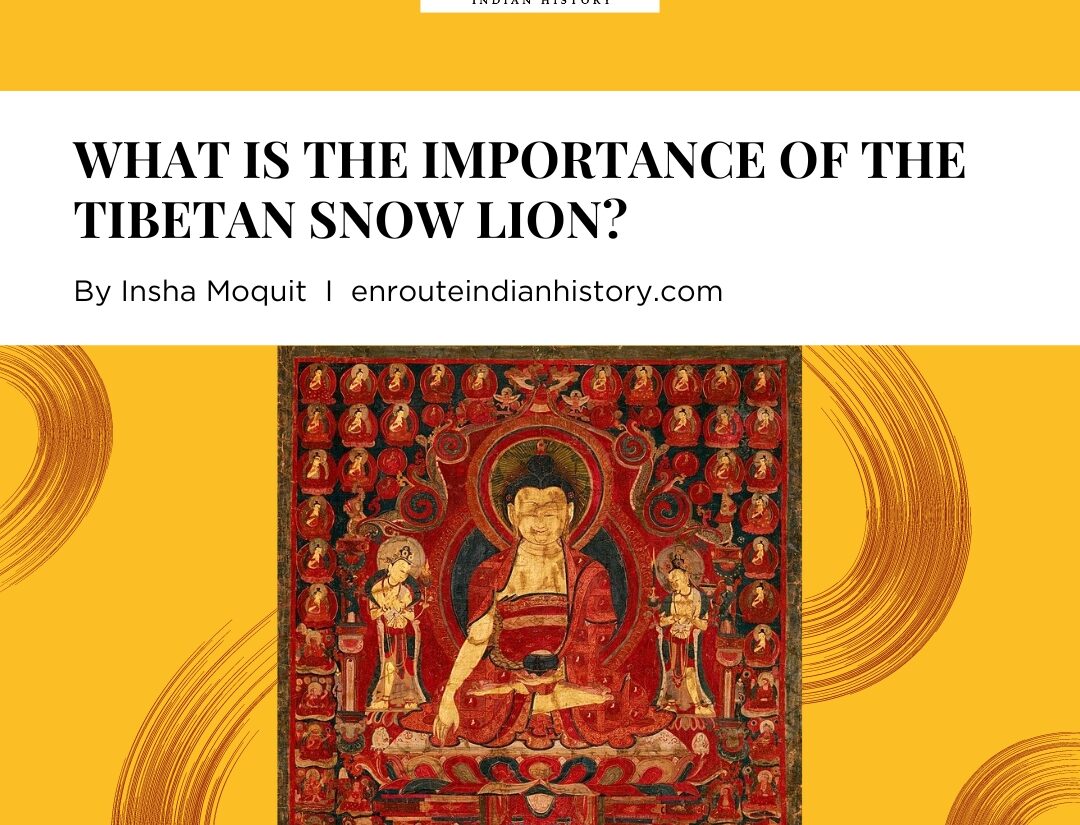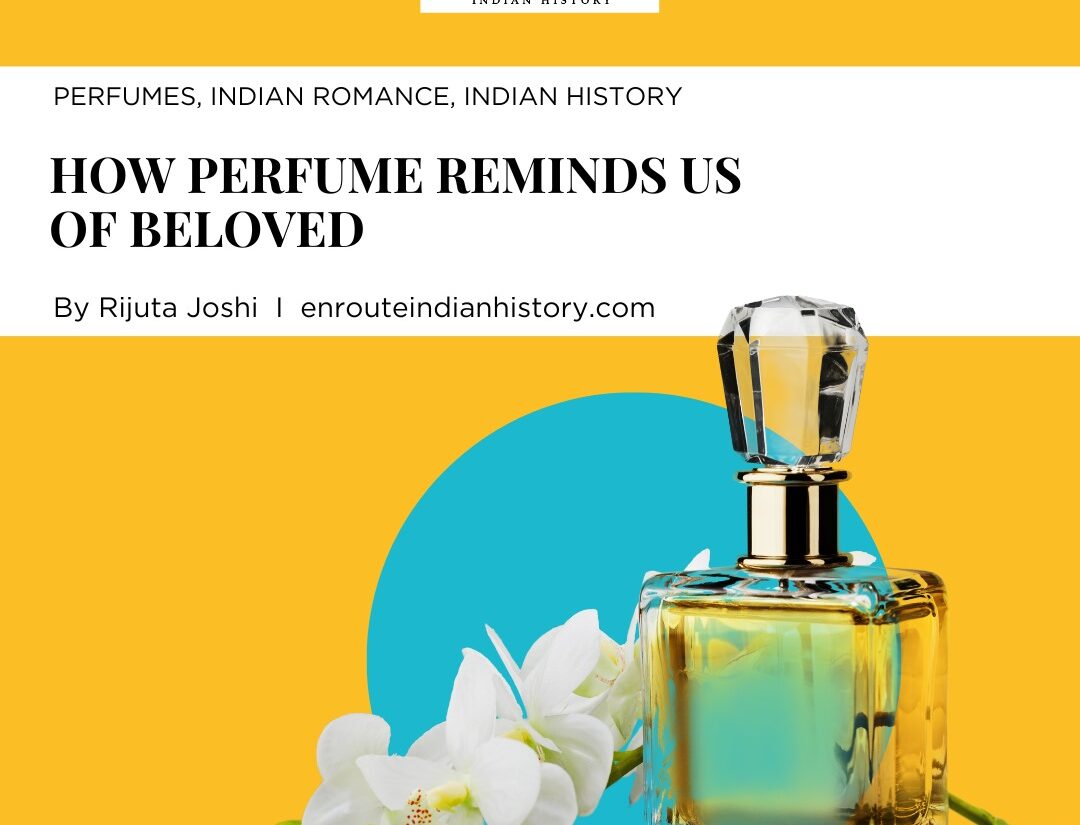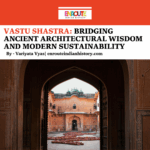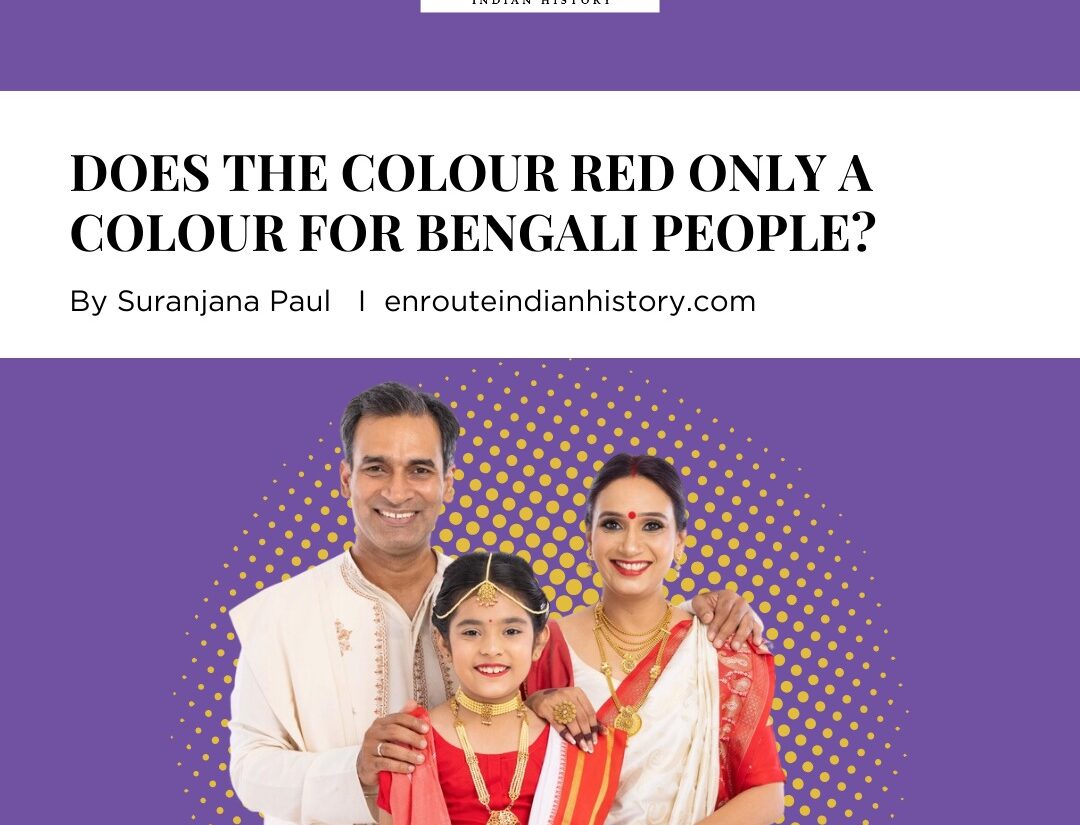
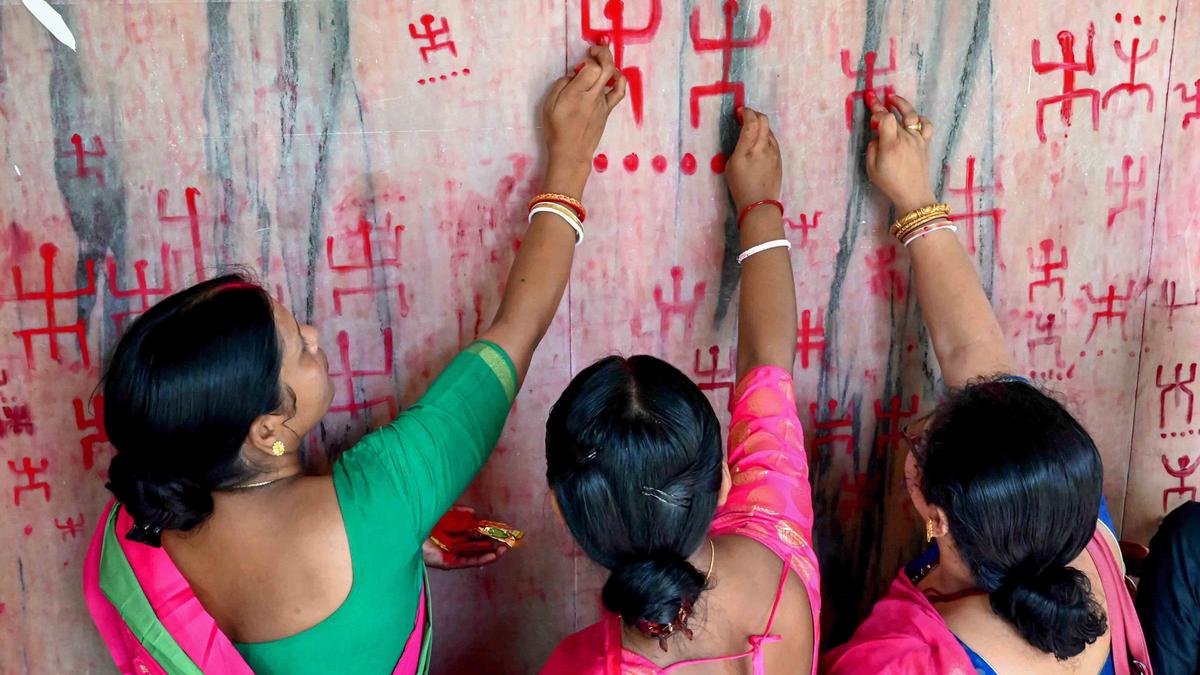
(Source: Hindu)
Does the Colour Red Only A Colour For Bengali People?
It is really strange that when I heard the topic is on colour the first line that came to my mind, was ‘Rangiye diye jayo jayo go ebar jabar age’ the popular Bengali song which is written by Rabindranath Tagore. There are very famous songs, and poetry in Indian literature that is based on colour, even rang is an important element in Indian culture. Colour or Rang is linked with symbolism, individual experience, culture, religious beliefs, and others. Different colours stand for different things, and even the symbolism of colour also differs from one region to another region. Still, the symbolism of colour connected the people of India with the thread of faith and belief in religious customs and traditional cultural practices through the festivals and celebrations. In India, the origin of most of the colours is related to the power and the mythical lives of the religious and regional gods and goddesses.
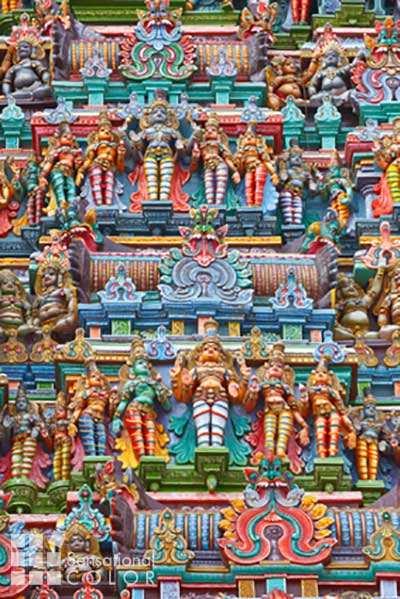
Menakshi Temple, Madurai, Tamil Nadu, India
(Source: Sensational Color)
The diversity of India also changes the representation of the colour. For instance, red is referred to as an auspicious colour in North India which is related to the Hindu Goddess Durga and also represents purity whereas the Southern part of India represents violence and anger referring to the colour red which comes with a negative sense.
The beauty of India lies in the words. When people hear the word Durga, a glimpse of Durga Puja comes into their mind and then another word comes into the people’s mind, it is Bengal. For Bengali people, Durga puja is one of the biggest festivals, especially in Kolkata and this festival is very much associated with the colour red. Here need to mention that like northern India, Durga is not only a goddess in Bengal, she is a daughter to Bengali people who come to baaperbari, the parents’ house for four days to visit her parents Menoka and Giriraj along with her four children, Kartikeya, Ganesha, Laxmi, Saraswati. On the last and final day, which is called Vijoyadasomi, she returns to her husband Lord Shiva’s place. On that farewell day, the people of Bengal celebrate some rituals with tears and smiles. According to the Bengali tradition, the married women wear white sarees with a red border which is known as sada-laal paar saree on the day of Dasomi, in the Durga puja. This also stands for a symbol, the combination of red and white refers to the goddess Durga where white symbolizes purity, simplicity, and patience and the colour red represents the new beginning, auspiciousness, fertility, power, and strength. They wear laal paar sada saree to boron maa Durga. The boron is a way to say goodbye to the goddess where the married women smear sindur on her forehead, shankha-pola, and feet and offer betel leaf by touching Devi’s face along with sweets and this custom carried forward with the sindur khela. This sindur khela is a happy and auspicious part of the day where married women smear red sindur on each other’s face and forehead to pray for long and happy lives for their husbands and children and also seek the strength and protection from maa Durga who is the symbol of power and womanhood.
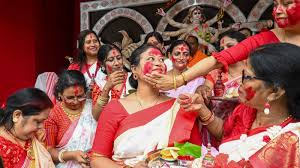
Sindur Khela
(Source: Hindustan Times)
Red sindur is very significant in Hindu culture as well as Bengali culture, it is an auspicious substance that stands for fertility and marital status and fertility is one of the aspects of the marriage system. This sindur is the most important element in a Bengali wedding. The whole process of the marriage is ended with the smearing of the red sindur by the groom on the forehead of the bride. In Bengali this ritual is called sindur daan, without sindur daan the marriage is incomplete. The groom cannot smear the sindur with his hand. To perform this ritual, he may use a ring, mirror, or kunke (a utensil which is used for measuring rice) and the most interesting part is that he needs to turn his face to another side while he is performing the ritual.
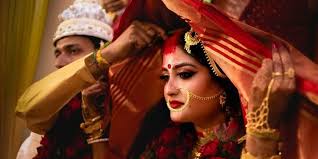
Sindur Daan
(Source: STYL. INC)
Shankha-pola is another symbol of marriage in Bengali culture. Pola is made from red coral which is paired with shankha, a white bangle that is made with conch shell. In Bengali tradition married women wear it in both hands along with kharu or iron or loha. On the morning of the wedding day, seven married women slipped on both the bengals to the bride’s wrists and according to the rituals the bangles should be gifted by the bride’s mother. This red and white combination of Shankha-pola is the mirror of the sada-laal paar saree and here also red stands for auspiciousness and white for purity. Women wear these two bangles for the well-being of their husbands.

Shankha-pola
(Source: Public Domain)
Alta is one of the important parts of Bengali culture. Normally, women apply red alta on the day of aiburobhat, the last day of bachelorhood in their parental house. Like, Shankha-pola, sindur without applying red alta the marriage is incomplete. Bride applies it on her hands, feet, and toes. The red colour of the alta is associated with love, passion, affection, and sacrifice for her husband. Like red sindur, red alta also stands for fertility. Alta is not only the symbol of marriage but also a part of Bengali culture and that’s why unmarried young girls also can wear it. The alta is also associated with Lakshmi, so in the post-wedding ritual, the newly married wife enters her in-law’s house by dipping her feet into thal of alta and walking into the house with the feet which are symbolic of entering Lakshmi in the house. Even in the Bengali tradition women adorn their feet with the colour red alta in the evening of every Thursday after reading the Lashmi-r panchali along with applying sindur to each other or on their own and also they touch the sindur on their Shankha-pola.
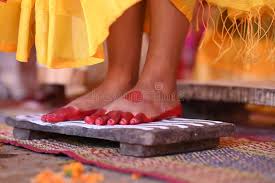
Alta
(Source: Public Domain)
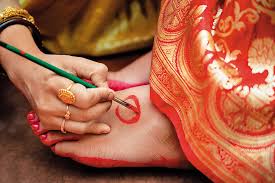
Applying the red colour alta on a woman’s feet
(Source: Outlook Traveller)
The Bengali wedding is full of red. Along with red sindur, red pola, red alta, red saree, and red tip or bindi or dot are integral parts of Bengali culture. Bengali brides usually wear laal Benarashi on their wedding day which helps to relate herself with Devi Laxmi. On the other side, red shringaar is to satisfy the Lajja Gouri who is the goddess of fertility a good conjugal life, and also for a long life of her man.

Aishwarya Rai as a Bengali Bride in the film Chokher Bali
(Source: Public Domain)
Apart from Bengali weddings and the Durga Puja the colour red is also used in different ceremonies and festivals. The whole article focuses on the traditional Bengali culture with which the whole of India is more or less accustomed due to the cinema, serials, or the exchange of the culture. Besides these religious patriarchal rituals, Bengal and Bengali people are deeply associated with the colour red due to their political history and the struggle which is still present in the blood of Bengali. This red does not believe in any discrimination rather people fight to end the discrimination under the red flag. In the post-independence period, the people of Bengal have seen several struggles under the red flag. So at the end of the writing, it can be stated that Red is not only a colour for Bengali, it is their culture, their emotion, and their identity.
Reference:
Chaudhary, S., Dutt, S. and Gupta, V., 2021. Colour symbolism across cultures: a dichotomy between German and Indian contexts. International Journal of Social Science and Economic Research, 6(5), pp.1545-1580. Available from: DOI: 10.46609/IJSSER.2021.v06i05.014 URL: https://doi.org/10.46609/IJSSER.2021.v06i05.014. [Accessed 29 June 2024]
Monalisa, M., 2023.Colour me red: Auspicious attire for Durga Puja. The New Indian Express. 23 October 2023. Available from: https://www.newindianexpress.com/cities/bengaluru/2023/Oct/23/colour-me-red-auspicious-attire-for-durga-puja-2626304.html#:~:text=The%20colour%20red%20symbolises%20strength,goddess%20Durga%20stands%20for%20symbolically. [Accessed 29 June 2024]
Uniyal, P., 2023. Durga Puja 2023: When is Sindur Khela and how is it celebrated? Know history, rituals, and significance. Hindustan Times. 23 October 2023. Available from: https://www.hindustantimes.com/lifestyle/festivals/durga-puja-2023-when-is-sindur-khela-and-how-is-it-celebrated-know-history-rituals-and-significance-101698058264793.html. [Accessed 29 June 2024]
Basu, A., 2024. Flavours of Bengal: Shankha. The Telegraph Online. 30 April 2024. Available from: https://www.telegraphindia.com/west-bengal/flavours-of-bengal-shankha/cid/1814064. [Accessed 29 June 2024]
Rajouria, A., 2023. Alta: The Red Indian Dye and Its Significance. Enroute Indian History. 18 September 2023. Available from: https://enrouteindianhistory.com/alta-the-red-indian-dye-and-its-significance/. [Accessed 29 June 2024]
- July 13, 2023
- 6 Min Read
